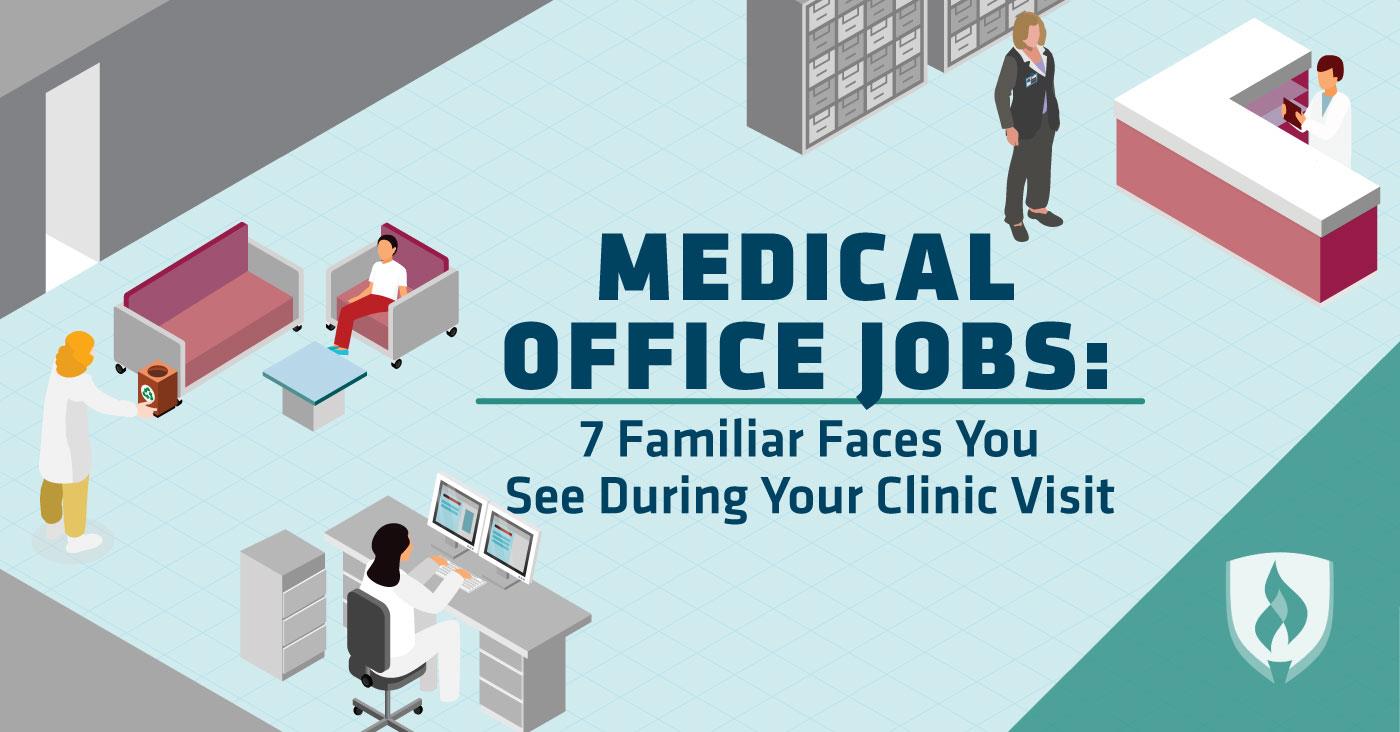Medical Office Jobs: 7 Familiar Faces You See During Your Clinic Visit
By Ashley Abramson on 03/09/2017

Have you ever wondered what everyone in your medical office or clinic does? Although doctors obviously play an integral role in the field of healthcare, supporting staff and providers help keep medical facilities running smoothly.
Because of the high volume of patients they serve, clinics typically function like well-oiled machines. Every individual plays their part to ensure each patient is well cared for from the beginning of their visit to the end of it. Have you ever thought about joining one of these healthcare teams?
From customer service roles like scheduling and checking in patients to the more frontline medical jobs that include assisting doctors and nurses, there are many medical office jobs to consider. We compiled some information to help you get to know each of these positions.
Who’s who in the medical office?
It takes a whole team to keep a medical office or clinic running smoothly, meaning there are a variety of jobs for different types of people. Explore your options below, but keep in mind that specific roles will vary depending on the facility.
1. Medical secretary
Job outlook (2014–2024): 14% or higher (much faster than average)
Medical secretaries, also called medical receptionists or medical administrative assistants, are usually the first person you interact with when you call or visit a clinic—they schedule your appointments or check you in for them. With specific knowledge of medical terminology and clinical procedures, they handle the administrative duties in the office, including appointment scheduling, billing patients, compiling and recording medical charts, reporting and correspondence.
To work as a medical secretary, you usually do not need a particular degree or certificate, but proficiency with technology and software along with customer service experience are often required.
2. Medical assistant
Job outlook (2014–2024): 23% (much faster than average)
The next person you’ll likely engage with at your clinic visit is the medical assistant. They will call you back, check your weight and vitals, and prepare you for your visit with the doctor or nurse. Like medical secretaries, medical assistants’ duties may include administrative tasks like charting and scheduling, but MAs work more directly with the patients and physicians. They also often draw blood and give injections.
Most medical assistants graduate from a postsecondary program ranging from the certificate level to an Associate’s degree. Earning a Medical Assisting Diploma is a common option, which can be completed in as few as 12 months.2 In order to become a certified medical assistant (CMA), which many employers prefer, you must complete an accredited program before sitting for the exam.
3. Registered nurse
Job outlook (2014–2024): 16% (much faster than average)
Depending on the reason for your visit, you may see a registered nurse (RN) before or in place of your visit with the doctor. RNs tend to be more medically focused and are directly involved in patient care plans. The job of a nurse includes recording medical histories and symptoms, administering medication, performing diagnostic tests, consulting and collaborating with other healthcare professionals, helping patients understand how to manage their conditions or injuries.
To work as a registered nurse, you will have to earn a college degree through one of two paths: A Bachelor of Science in Nursing (BSN) or an Associate’s Degree in Nursing (ADN). After obtaining a degree, you’ll also have to pass the NCLEX exam to become licensed to practice.
4. Medical lab technician
Job outlook (2014–2024): 16% (much faster than average)
If your nurse orders lab tests like blood draws or urine samples, you may work with a medical lab technician next. Medical lab techs draw samples of bodily fluids, tissue or other substances. Operating sophisticated laboratory equipment, medical lab techs also analyze the samples they collect and record any normal or abnormal findings and discuss them with physicians, who then diagnose potential issues.
Medical lab techs typically graduate from an Associate’s Degree program, which can be done in as few as 21 months.2 Some states will also require you to acquire a license.
5. Radiologic technologist
Job outlook (2014–2024): 9% (faster than average)
When your physician needs more information to make a diagnosis, they call upon a radiologic technologist to obtain an X-ray, MRI, CT scan, ultrasound or other diagnostic imagery. Radiologic techs, sometimes referred to as X-ray techs, use advanced technology to create images for doctors to analyze. In addition to performing the scans, radiologic techs also maintain diagnostic equipment, prepare patients for procedures, keep patient records and work closely with physicians to evaluate the images they take.
If you want to work as a radiologic tech, you’ll likely need an Associate’s degree, which can be earned in just 24 months.2 In most states, you will need to be licensed or certified.
6. Pharmacy technician
Job outlook (2014–2024): 9% (faster than average)
Some clinics have adjacent pharmacies to make prescription pick-up convenient. If you receive a prescription from your primary care provider, you might make the pharmacy your last stop of your clinic visit. Pharmacy technicians assist pharmacists in completing orders from doctors, in both preparing and dispensing medications for patients. In addition to collaborating with pharmacists to fill prescriptions, pharmacy techs also work closely with customers, taking phone calls and entering information when needed. They may also work with insurance companies to handle claims.
There are no official requirements to becoming a pharmacy tech, though many graduate with a Postsecondary Certificate or Diploma program before launching their career. This can be done in as few as nine months.2 Depending on state regulations, you may also need to earn additional certification as well.
7. Health information technician
Job outlook (2014–2024): 15% (much faster than average)
The work in a medical clinic doesn’t stop after your appointment ends. All of the data the medical assistants, nurses, technicians and doctors compile in your medical chart needs to be managed. That’s where health information technicians come in. They specialize in maintaining quality, accuracy, confidentiality and accessibility in both paper and electronic file systems, coding and categorizing all the information for insurance billing purposes.
Many health information technicians earn an Associate’s degree, which can be acquired in as few as 18 months.2
Join the healthcare team
As you can see, it takes a whole team of healthcare professionals to keep a facility running smoothly. Whether you want to work directly with patients or behind the scenes, one of these medical office jobs could be the rewarding career you’ve been seeking.
And the good news is it won’t cost you several years in school to land one of these positions. Learn more in our article, The Ultimate List of Healthcare Jobs You Can Launch in 2 Years or Fewer.
RELATED ARTICLES:
- Medical Jobs Without Blood: A Beginner’s Guide
- 11 Entry-Level Healthcare Jobs Employers Want to Fill NOW
- Who’s Who in a Hospital: Your Visual Guide to Medical Jobs [Infographic]
- 5 Coveted Careers in Healthcare Non-Medical Professionals Need to Consider
1Data represents national, averaged earnings for the occupations listed and includes workers at all levels of education and experience. Employment conditions in your area may vary.
2Time to complete is dependent on accepted transfer credits and courses completed each quarter.




